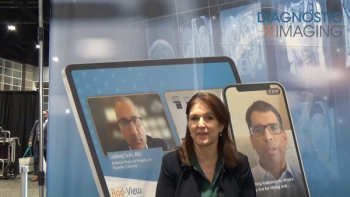
ECR decides to hold meeting annually, vexing cost-conscious vendors
Companies say they will scale back participationMedical imaging vendors are expressing concern over the EuropeanCongress of Radiology's decision this month to begin holding itsmeeting annually starting in 1999. While imaging executives saythey
Companies say they will scale back participation
Medical imaging vendors are expressing concern over the EuropeanCongress of Radiology's decision this month to begin holding itsmeeting annually starting in 1999. While imaging executives saythey support the scientific goals of such a move,they may cutsupport for the ECR's commercial exhibit due to the higher costsof an annual meeting.
The ECR meeting, which is held biennially, has carved out a successfulniche for itself since moving to Vienna in 1991. The conferencehas proved particularly adept at attracting radiologists fromformer Soviet Bloc states in Central and Eastern Europe. Attendanceat this year's meeting topped 12,000.
From a vendor standpoint, however, the ECR conference suffersfrom its March time frame, which comes only a few months afterradiology's showcase conference, the Radiological Society of NorthAmerica meeting held in November. As a result, there are usuallyfew major new product introductions at the ECR show.
But the lack of new product news hasn't stopped vendors from enthusiasticallysupporting the ECR conference, and demand for booth space at theAustria Center Vienna has outstripped supply in recent years.The ECR had to turn away some 30 companies that wanted to exhibitat the center, according to Dr. Hans Ringertz, president of ECR`97 and chair of radiology at Karolinska Hospital in Stockholm,Sweden.
"That was without promotion," Ringertz said at an ECRnews conference March 3. "With promotion we could doublethe exhibition space with no problem."
The decision to hold annual meetings was made in conjunction withnegotiations with the city of Vienna over an expansion of theAustria Center that will add 7000 square meters of exhibit spaceto the hall, according to Ringertz. In exchange, the ECR agreedto hold at least five meetings in Vienna over the next 10 yearsstarting in 1999. Thus, the ECR meeting will be held in 1999,2000, and annually thereafter.
The ECR's decision was not greeted with enthusiasm by some medicalimaging companies, most of which have been forced to cut costsin the face of the global slowdown in imaging device sales. Companiesare already chafing at higher costs at the RSNA conference, notto mention the various national radiology meetings in Europe atwhich they must also exhibit.
In off-the-record conversations, many executives said that theywere dismayed by the ECR's decision, which would result in extraexhibiting costs. On the record, vendors were more diplomatic,but expressed reservations about the plan.
Executives with GE Medical Systems Europe of Buc, France, forexample, stated that while they supported the scientific goalsof an annual meeting, they would not maintain the same level ofsupport for an annual ECR meeting as they do for the biennialconference.
"We don't have the money to spend on so many exhibitions,"said Arno Bohn, former president and CEO of GE Medical SystemsEurope and now chief executive of GE Germany. "I'm opposedto the cost that goes with an annual meeting."
Bohn suggested that GE and other vendors might fully support oneECR meeting every other year, while in intervening years, companiesmight scale back their involvement by displaying in smaller booths.Technology could provide a partial solution, with vendors in offyears using "virtual exhibitions" in which equipmentis displayed on World Wide Web pages that can be accessed at acompany's booth.
Hans Barella, recently named chairman of Philips Medical SystemsInternational in Best, the Netherlands, echoed Bohn's sentiments.
"We would not want to see a second annual major technicalexhibition, because we think it is simply too costly for the industry,and in the end the medical customers have to pay for it,"Barella said. "If this is to be an annual meeting, at leastthe exhibition could be one which is much more focused on teaching,which in particular the Eastern European countries can benefit,and in which we can avoid having too much equipment displayed."
Newsletter
Stay at the forefront of radiology with the Diagnostic Imaging newsletter, delivering the latest news, clinical insights, and imaging advancements for today’s radiologists.




























